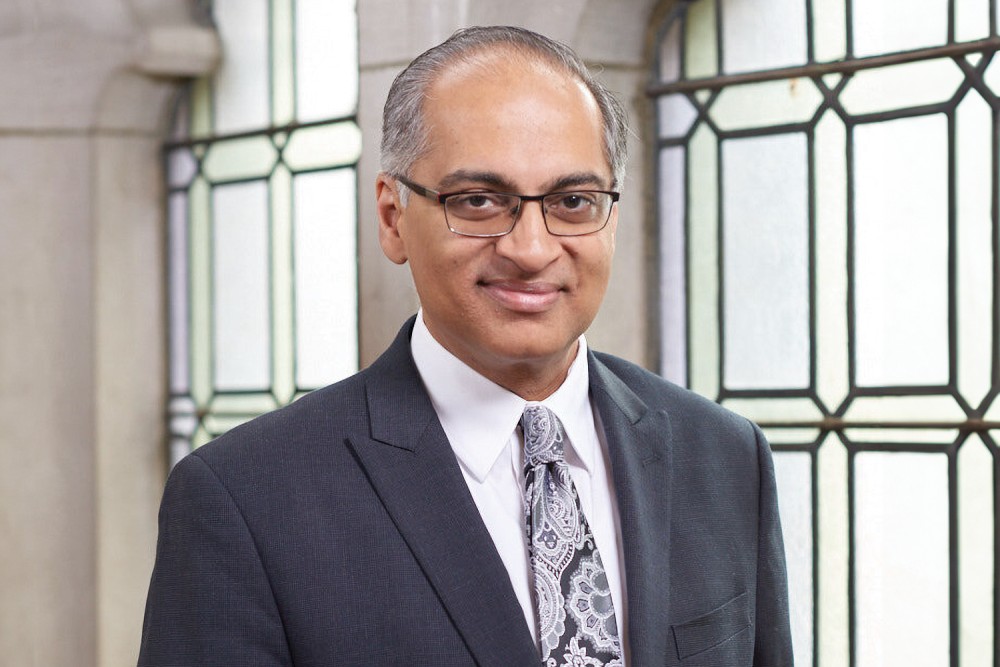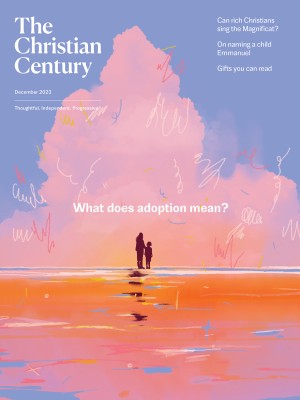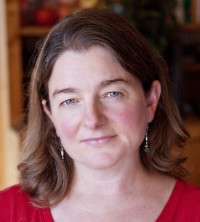Searching for home in the world’s religions
“Why is it that being a Buddhist Christian is often flagged as a problem,” asks theologian John Thatamanil, “but being a capitalist Christian is not?”

Theology professor John Thatamanil (Courtesy of Union Theological Seminary)
John Thatamanil, a native of India, is a professor at Union Theological Seminary in New York, where he teaches comparative theology, religious diversity, Hindu-Christian dialogue, the theology of Paul Tillich, theory of religion, process theology, and eco-theology. He’s the author of Circling the Elephant: A Comparative Theology of Religious Diversity and the forthcoming book Desiring Truth: Comparative Theology and the Quest for Interreligious Wisdom. Hear the full version of this interview on the Century podcast In Search Of.
What were you in search of when you started on your path to interreligious studies?
I was in search of home. I came to the US when I was eight and a half years old, and I pretty quickly realized that most of the things I was told about what it means to be Indian came in the form of constraint. Being a good Indian meant that I could not date, could not go to the prom, etc.
Read our latest issue or browse back issues.
So I thought, what does it mean to be Indian? When you’re an Indian Christian, your Christianity doesn’t help, because that’s just something more that you have in common with the majority of the United States. But the interest in other religious traditions—Hinduism, Buddhism—was something distinctively Indian that did not feel like a constraint.
My Sunday school teacher, to his great credit, assigned The Religions of Man, by Huston Smith. When I read the chapters on Hinduism and Buddhism, I was just captured. So that’s that search for a deeper sense of what it means to be Indian, one that I could embrace and rejoice in.
Yet there was something important to you about keeping your roots in the Christian tradition.
Absolutely. The Mar Thoma Church is this curious concoction, because it is influenced by the Anglican missionaries that came to India. What resulted was a kind of hybrid church that kept the liturgy and sensibility of the Syrian Orthodox Church, but with a kind of Protestant-inflected theology. But that combo was never anti-intellectual, fideistic, or anti-reason. So I never had to jettison my tradition in order to find something more satisfying. My interest in other religious traditions is prompted not by a sense of something missing in mine but by a sense of inexhaustible richness in the other.
There’s a practical aspect of this for you as well, right?
Absolutely. In more recent years, the practices come from studying with Lama John Makransky, who is part of a strand of the Tibetan Buddhist tradition. That practice is a kind of Dzogchen practice. It’s something I try to do every day.
Would you say that your actual religious practice is more influenced by Buddhism or by Christianity?
That’s complicated. On Pentecost of 2021, I was ordained an Anglican priest. So one of my primary practices is eucharistic life, and that remains very dear to me. But in addition to that, the Buddhist practice is also present.
Some of us use the term “multiple religious participation” to capture people like me. Some even go so far as to talk about “multiple religious belonging.” Belonging is recognized by both sides of the fence: if you’ve taken a bodhisattva vow and are welcomed into a Buddhist community without being kicked out of your Christian one, then you can claim a kind of double or multiple belonging.
I find it safer to say that I am someone who engages in multiple religious participation—because I’m really truly at home within the eucharistic life of the Christian church, but I supplement that with my Buddhist practices.
There are a lot of people in the United States who aren’t as clear about this as you are but who still find different religious traditions attractive at different moments in their lives. There’s some anxiety hanging around about “syncretic practice.”
I often ask people an intentionally punchy question: Why is it that being a Buddhist Christian is often flagged as a problem, but being a capitalist Christian is not? Suppose that to be religious is a matter of what one does with one’s desires—to what do I give my heart? Well, truth be told, there has never been a more effective way of disciplining the heart invented in history than the market.
Your pastor has, if you’re in a mainline denomination, maybe an hour-long service to shape your desires in a Christlike direction. But the market has you while you sleep. You dream capitalist dreams. Trying to combine that with Christianity is fundamentally incompatible, because one is about serving others in love and the other is fundamentally about making you into an acquisitive consumer.
That kind of syncretism doesn’t raise any red flags.
That is such a great description of how we go about deciding what “other” gets included or excluded in our religious life or practice.
Which is to say we are always already multiple and syncretic. We cannot not be that way. The aspiration toward singularity might be lovely, but it’s difficult to pull off.
Why do you see religious diversity as a promise for Christians and not a problem?
If I’m truly, as a Christian, to affirm that core affirmation that God does in fact so love the world, then divine disclosure must be happening far beyond the boundaries of the Christian tradition. How God engages in self-disclosure under different vocabularies, different practices, must matter. If I give myself to the other in love, I will be opened not merely to that person but to what the person treasures, what inspires that person, what gives them life. In this movement of love toward my neighbor, I will find myself caught up in a movement toward the mystery. So I now say that there is no movement toward God without a movement toward my neighbor.
What do you do when a religion makes universal claims? For example, that Jesus is the only son of God.
The classic way is a kind of inclusivism. The Gospel of John begins with precisely this affirmation that the Word who was with God and who is God is the light that illuminates not some people but every person. The classical strategy within the Christian tradition is to say something like what we know in full, others have at least in part.
Though there have long been strategies in the tradition to say that Christ is known to others, now some of us in Christian theology have moved to a pluralist posture that says that there are many genuine disclosures of divinity—and that we will be richer when those are brought into dynamic conversation.
In working toward that pluralism, you’ve also called into question this category of religion.
We’ve long had our traditions, but our traditions have not long been religions. Anthropologist Talal Asad makes the point that you can’t have something called religion until you have something else, that is, the “secular.” Only when we have those two terms do we have religion in anything like a recognizably modern sense. We have to be taught that some parts of our lives are religious and some parts are not. So economics, the market, politics—that’s not religious. Religion gets cordoned off into the inward realm, and the public realm is handed over to the various sciences—social, political, economic.
When our traditions did get religionized and put into that religion box, the first tradition to get religionized, I think, was Protestantism. So there are many features of what we think of as religion that are really features, perhaps first, of a Protestant tradition. So our traditions get scripturalized, they get literalized, they get creedalized, they get reified, in the sense that the idea emerges that you can only belong to one religion at a time. That, too, just does not apply for most parts of the world. We’ve baked the notion that you can only be one religion at a time into our understanding of what gets to count as a religion.
Can you walk us through the relationships between desiring and knowing in different traditions?
My friend Donovan Schaefer points out that the very idea that thinking and feeling are two separate operations is itself a questionable notion. That feeling is one thing and thinking is another is one of the ideas that seems baked into contemporary Western life. The two are sometimes even rendered into opposition. If I’m to think clearly, I must feel less.
It turns out that there’s no philosophically or neurologically credible way of policing that distinction. There’s no part of the brain that is only doing thinking and not feeling. We need to attend to feeling carefully because it might itself be a source of knowing. In academic circles, some people have even started talking about critical feeling, rather than just critical thinking. Feeling is not the enemy of knowing—but miseducated, untutored feeling might well be.
Or feeling that is at the mercy, for example, of the marketplace.
Absolutely. In Hindu and Buddhist traditions, every perception of anything whatsoever is said to be accompanied by a feeling valence. So if I see a book, I don’t just see that book. I see it accompanied and inseparable from a kind of signal—like an affirmative signal or a signal of “ugh, that’s homework.” What we try to do in practice is attend to the way in which those feeling valences are shaped by egoism. For example, that book might be a lovely book, but because I’ve associated it with homework, my narrow, egoistic frame has led me to misperceive it in a negative key.
Part of what one does in order to know well and truly is to attend to the affects that are always accompanying our knowing and tutor them, so one is not at their mercy. Tutoring feeling—and attuning feeling—is inseparable to the work of knowing.
In the kinds of Buddhist practice that I’m engaged in, if I don’t actually mobilize outward a kind of loving kindness and compassion, if I am not lovingly disposed toward the real, I won’t see it. It’s not a claim that I must become like Spock, which is a terrible way of misreading Buddhist traditions. On the contrary, there is this sense that a kind of falling open to reality can happen both cognitively and affectively. Mahayana Buddhist postures are about the unity of wisdom and compassion woven together, sometimes even depicted as male and female in coitus. Both have to be intimately wedded if I’m to be open to the real.
I hear you saying that truth is love and love is truth.
If you read Gandhi carefully, there’s something like a deep mathematical equation that can be pulled out from the whole of his corpus, and it reads something like this: the truth equals nonviolence equals love. For him, those were interchangeable propositions.
What I’m saying seems to be anticipated in one of the most dramatic scenes in the gospels. Jesus is standing before Pilate, and Jesus speaks about the truth, and Pilate says, “Truth? What is truth?” (John 18:38). Those who wield power often are under the impression that the truth is whatever they say it is, because they can actually change the circumstances by imposition and fiat. So truth seems to them to be an imposition, a thing they can do to the fabric of reality because they can say “make it so” and it gets made so.
There’s a kind of intimacy between Pilate’s capacity to exercise controlling violence and Jesus, who does not play that game. He’s trying to tell Pilate, “If I were your sort of king, I could exercise power, but I’m not your kind of king.” Pilate, of course, only hears the word king and says, “Oh, so you are a king.” Jesus is saying, “My kingdom is not of this world,” not of this world where coercion and manipulation and imposition appear to dictate the facts of the circumstance. He is saying that his kingdom is that of love, which is synonymous with truth, which is letting things show themselves as they are in all their beauty and distinctiveness and generosity rather than violence and manipulation.




